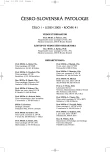-
Medical journals
- Career
Nervous Component of Mature Cystic Ovarian Teratomas
Authors: A. Kohout
Authors‘ workplace: Fingerlandův ústav patologie Lékařské fakulty UK a Fakultní nemocnice, Hradec Králové
Published in: Čes.-slov. Patol., 41, 2005, No. 1, p. 19-28
Category: Original Article
Overview
In 30–50 percent of cases mature cystic ovarian teratomas contain a nervous tissue which can be highly differentiated. This study was focused on research of the nervous component of mature cystic ovarian teratomas with generally available methods to pathologists, including impregnation techniques, immunohistochemistry and electron microscopy.
From the total number of 212 mature cystic ovarian teratomas, the nervous tissue was found in 72 cases (34%), which corresponds to the literature data. According to its differentiation, it was possible to distinguish five categories of nervous tissue by light microscopy: 0 peripheral nervous tissue only, 1 – solid glial nodules, 2 – glial cysts, 3 – glial tissue with abundant scattered neurons and, finally, 4 – organoid nervous tissue similar to certain CNS structures. Apart from the foci similar to grey matter of the spinal cord and cerebral cortex, those of differentiated cerebellar cortex were present as well. Astrocytes mostly predominated in the nervous tissue, and they sometimes showed reactive changes including gemistocytes and formation of Rosenthal fibres. Neuronal elements also showed degenerative changes quite frequently, especially in a less differentiated nervous component. These changes might have developed due to an abnormal location of the nervous tissue or its hypoxia in the teratoma. Contrary to some literature data, oligodendrocytes and myelin were present in the nervous tissue of most of our cases. Ultrastructurally, neurons with fully developed synapses were observed in the nervous component, and dendritic spines were present on dendrites of Purkinje cells of cerebellar cortex. The results obtained from the examination of teratomas in this study confirmed and enriched the literature data concerning the high degree of differentiation of their nervous components. We suggest that the differentiated nervous tissue of teratoma represents a unique natural model suitable for research of some aspects of neurohistology and neuropathology, e.g. synaptogenesis or myelinogenesis.Key words:
mature cystic ovarian teratoma – nervous tissue – differentiation – synapsis – electron microscopy
Labels
Anatomical pathology Forensic medical examiner Toxicology
Article was published inCzecho-Slovak Pathology

2005 Issue 1-
All articles in this issue
- Acute Aortic Syndromes
- The Role of the Extracellular Space in Biology of Glial Brain Tumors
- Nervous Component of Mature Cystic Ovarian Teratomas
- Acinic Cell-like Carcinoma and Acinic Cell-like Change in Ductal Hyperplasia of the Breast – Report of Two Cases
- Anaplastic Carcinoma of the Thyroid Gland with Chondrosarcomatous Component
- Czecho-Slovak Pathology
- Journal archive
- Current issue
- Online only
- About the journal
Most read in this issue- Acute Aortic Syndromes
- Nervous Component of Mature Cystic Ovarian Teratomas
- Anaplastic Carcinoma of the Thyroid Gland with Chondrosarcomatous Component
- The Role of the Extracellular Space in Biology of Glial Brain Tumors
Login#ADS_BOTTOM_SCRIPTS#Forgotten passwordEnter the email address that you registered with. We will send you instructions on how to set a new password.
- Career
